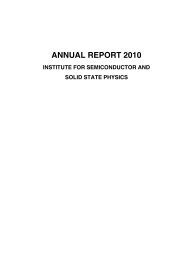Kinetic and Strain-Induced Self-Organization of SiGe ...
Kinetic and Strain-Induced Self-Organization of SiGe ...
Kinetic and Strain-Induced Self-Organization of SiGe ...
You also want an ePaper? Increase the reach of your titles
YUMPU automatically turns print PDFs into web optimized ePapers that Google loves.
8 CHAPTER 1. SILICON-GERMANIUM MATERIAL SYSTEM<br />
DA double steps have a by far subordinate abundance. Fig. 1.5 (after [8]) depicts a schematic<br />
model <strong>of</strong> the most common step types on Si(001) showing SB <strong>and</strong> DB steps in their rebonded<br />
configuration. [8].<br />
1.2.2 Step Types in Different Miscut Angle Regimes<br />
For small miscuts below 1 ◦ only mono-atomic steps with a height <strong>of</strong> 0.136 nm (i.e. aSi/4)<br />
are found. Both single-step types are present but reveal a different nature. Whereas the<br />
SA-steps are rather straight <strong>and</strong> smooth, the SB-steps appear rugged. There are many SA-<br />
kinks in SB-steps <strong>and</strong> few SB-kinks in SA-steps as it costs less energy to create an SA step<br />
segment [11].<br />
Fig. 1.6 [12] shows an STM image (∼ 350 ˚A × 350 ˚A) <strong>of</strong> such a typical vicinal Si(001) surface<br />
with a low miscut <strong>of</strong> 0.66 ◦ along [110]. Equally spaced A- (orange) <strong>and</strong> B-terraces (violet) can<br />
be clearly discerned. The regular (2×1)-reconstruction is revealed as dimer-rows spanning<br />
along the 〈110〉-directions over the terraces with an altered orientation parallel (A-terrace)<br />
<strong>and</strong> perpendicular (B-terrace) to the step-edges. Thus the B-terraces are defined by rugged<br />
SB-steps at the lower side <strong>and</strong> rather straight SA-steps at the upper boundary.<br />
Figure 1.6: STM image (∼ 350 ˚A × 350 ˚A) <strong>of</strong> a vicinal Si(001) surface with a<br />
miscut <strong>of</strong> 0.66 ◦ along [110] revealing equally spaced A- (orange) <strong>and</strong> B-terraces<br />
(violet). The regular (2×1)-reconstruction is revealed as dimer-rows spanning along<br />
the 〈110〉-directions over the terraces with an altered orientation parallel (A-terrace)<br />
<strong>and</strong> perpendicular (B-terrace) to the step-edges. Thus the B-terraces are defined<br />
by rugged SB-steps at the lower side <strong>and</strong> rather straight SA-steps at the upper<br />
boundary. [12]<br />
� Source: <strong>SiGe</strong> STM stepped-surface.jpg











